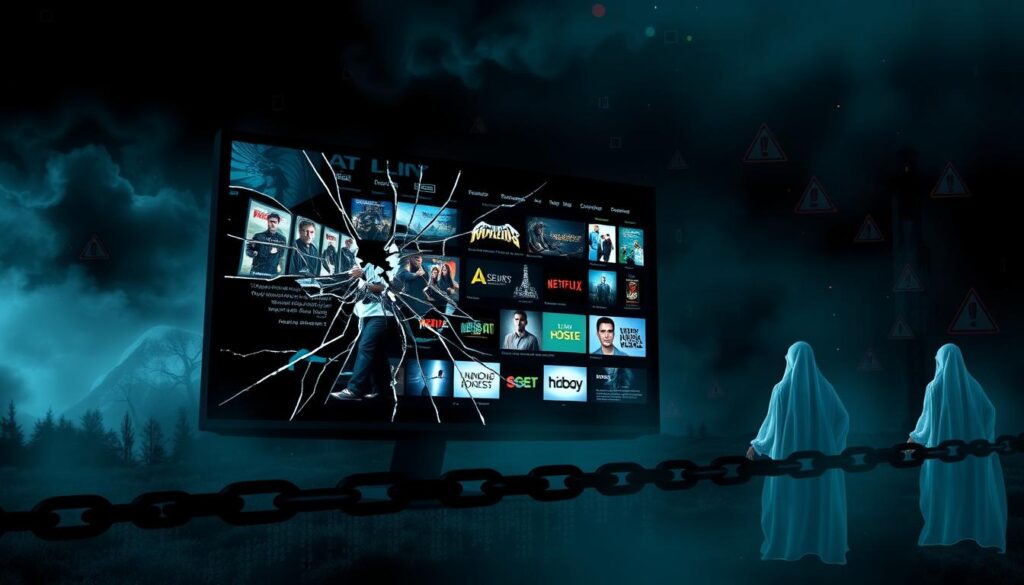Introduction
As streaming technology continues to evolve, the use of IPTV cracks remains prevalent in Canada despite the risks involved. These unauthorized streaming services have now integrated advanced technologies such as Docker containers, making them increasingly difficult to detect and regulate. Understanding the risks associated with IPTV cracks is more critical than ever. This article explores how IPTV cracks function, the dangers they pose, and the importance of opting for legal streaming alternatives in 2025.
Key Takeaways
- IPTV cracks pose significant cybersecurity and personal data risks.
- Docker vulnerabilities are being exploited in IPTV piracy.
- Legal streaming alternatives provide safer and more reliable access to content.
- Understanding Canadian copyright laws can help mitigate legal ramifications.
- Cybersecurity concerns highlight the need for increased awareness and education on safe streaming practices in Canada.
Understanding IPTV Cracks: A Brief History

IPTV piracy has evolved significantly over time. Initially, piracy revolved around physical media sharing, such as CDs and DVDs. The emergence of file-sharing platforms in the late 1990s, including Napster and BitTorrent, revolutionized the way digital content was distributed illegally.
In the 21st century, piracy methods became increasingly sophisticated. As demand for easily accessible and cost-effective content grew, IPTV cracks emerged as a means to bypass subscription fees. These unauthorized streaming services provided users with instant access to a vast array of content, challenging traditional cable providers.
The history of IPTV piracy underscores the ongoing battle between content creators and digital pirates. Understanding the evolution of piracy is crucial in addressing the issue today.
How IPTV Cracks Work
Technical Insights and Mechanisms
IPTV cracks exploit vulnerabilities in streaming technology to provide unauthorized access to content. These methods bypass security checks and encryption protocols, allowing users to stream premium content for free.
A common technique involves acquiring login credentials through phishing attacks or data breaches. Unauthorized users can then access streaming services without detection.
Another approach involves modifying IPTV boxes with custom firmware or patches to override security measures. Additionally, specialized network configurations enable uninterrupted streaming.
Common Software and Tools Used
Several software tools facilitate IPTV piracy. Applications such as Kodi with illegal add-ons, Xtream Codes, and modified APKs are widely used. These tools are often paired with VPN services to obscure user locations and avoid detection.
Piracy tools frequently include lists of illegal channels, simplifying content discovery. Some setups also utilize advanced networking hardware to enhance streaming performance. Despite their functionality, these practices remain illegal and pose significant risks.
The Dangers of IPTV Cracks
The widespread use of IPTV cracks exposes users to various dangers. Cybersecurity threats are among the most significant concerns. Unauthorized streaming services often distribute malware, putting users at risk of hacking and data breaches.
Statistics indicate a high prevalence of cybersecurity threats associated with IPTV cracks. Keywords such as “malware,” “hacking,” and “data breach” highlight the scale of these risks. Users unknowingly expose themselves to fraud, identity theft, and financial losses.
Network security vulnerabilities further exacerbate these risks. Weak security configurations in IPTV setups increase the likelihood of cyberattacks, making unauthorized streaming even more hazardous.
Ultimately, illegal streaming carries severe consequences, including potential legal action and financial penalties. Raising awareness about these dangers is essential in promoting safer viewing habits.
The Role of Docker in IPTV Cracks
Docker’s container technology has significantly contributed to the evolution of IPTV piracy. Understanding its role in unauthorized streaming is crucial for addressing the associated risks.
How Docker is Utilized
Docker has become a preferred tool among IPTV pirates due to its ability to create isolated application environments. By leveraging Docker, pirates can streamline their operations while evading detection.
Additionally, Docker enables rapid software updates, allowing IPTV pirates to bypass security measures effectively. Its capabilities in network security and data manipulation further enhance the efficiency of unauthorized streaming services.
Technical Vulnerabilities
The use of Docker in IPTV piracy introduces several security vulnerabilities. The sheer volume of data processed within Docker environments increases the risk of breaches. Furthermore, the use of multiple programming languages complicates security efforts, adding layers of potential weaknesses.
Poor documentation and insecure configurations further contribute to these risks. Addressing these vulnerabilities is essential in mitigating the impact of Docker-enabled IPTV piracy.
IPTV Crack Evolution: A Closer Look at Docker
The integration of Docker into IPTV piracy has transformed unauthorized streaming services. This shift has made it increasingly difficult for authorities to combat piracy effectively.
Recent Trends in 2025
By 2025, the use of Docker has become a dominant trend in IPTV piracy. Pirates utilize Docker to enhance performance, automate operations, and conceal their activities from law enforcement. This technological advancement has made it harder to disrupt unauthorized streaming services.
Examples of New Techniques
Recent innovations in IPTV piracy involve sophisticated scripts that exploit streaming vulnerabilities in real-time. Pirates also employ adaptive algorithms to modify streaming data dynamically, making it challenging for authorities to track and block illicit content.
Companies like Intersoft Data Labs specialize in developing advanced software solutions. While their work is legal, similar techniques are often repurposed by IPTV pirates to optimize their services.
These developments highlight the ongoing challenge of combating piracy in an increasingly digital world.
Legal Implications and Risks in Canada
Unauthorized IPTV services pose significant legal risks in Canada. The country enforces strict anti-piracy laws to protect intellectual property rights.
Canadian Laws and Regulations
Canada’s Copyright Act explicitly prohibits unauthorized IPTV streaming. Section 41.25 criminalizes the circumvention of digital protection measures. Both content providers and users of illegal IPTV services may face severe consequences.
Potential Penalties and Fines
Violating Canada’s Copyright Act can result in substantial fines and legal repercussions. Businesses involved in IPTV piracy can be fined up to $1,000,000, while individual users may be penalized up to $20,000 per infringing instance. In severe cases, offenders may face up to five years in prison.
These stringent penalties underscore the importance of adhering to legal streaming practices.
Legal Alternatives to IPTV Cracks

Given the risks associated with IPTV piracy, exploring legal alternatives is the best course of action. Legal streaming services offer secure and high-quality content access without the threat of legal repercussions.
Subscription Services
Subscription-based platforms remain the most reliable option for legal streaming. In Canada, services such as Netflix, Disney+, and Amazon Prime Video provide extensive content libraries at reasonable prices. These platforms ensure compliance with copyright laws while delivering a seamless viewing experience.
Freemium Models
Freemium streaming services offer an alternative to paid subscriptions. Platforms such as Spotify, Peacock, and Tubi provide free content with optional premium upgrades. This model allows users to access entertainment legally while avoiding the risks associated with IPTV piracy.
For those seeking legitimate IPTV services in Canada, comparing available options against traditional cable services can help identify the best solution.
Conclusion
The evolution of IPTV piracy, particularly through the integration of Docker, has made illegal streaming more sophisticated and challenging to combat. However, the risks associated with IPTV cracks—including cybersecurity threats, legal consequences, and financial penalties—make them an unwise choice.
By opting for legal streaming alternatives, consumers can enjoy secure and high-quality content without fear of malware, data breaches, or legal action. Raising awareness and educating users about safe streaming practices is crucial in ensuring a secure digital entertainment landscape in Canada.
Enhancing IPTV Security with Docker

In today’s digital landscape, securing IPTV services is more crucial than ever. Docker plays a significant role in strengthening security by offering robust isolation features, thereby mitigating potential risks. Its containerized architecture ensures rapid and widespread updates, enhancing the overall security posture.
Effective utilization of Docker involves implementing specific security measures and tools. Secure file backup solutions such as Nextcloud and Proton Drive contribute to safeguarding IPTV streams and associated data.
By compartmentalizing each component of the IPTV system within isolated containers, Docker minimizes vulnerabilities and fortifies stream security. This approach also allows administrators to deploy IPTV services across diverse platforms, including gaming consoles and NAS devices, ensuring adaptability to evolving security demands.
To enhance IPTV security through Docker, automated container updates are essential. Granting minimal necessary privileges to containers and conducting regular image vulnerability scans further strengthen security. Additionally, Linux-based tools like Audacity enhance Docker’s ability to maintain service integrity.
Docker’s compatibility with audio applications like AIMP also facilitates secure data management. This structured approach to IPTV security ensures compliance with regulatory requirements, thereby mitigating legal risks.
Conclusion
An in-depth analysis of IPTV Crack Evolution and Docker highlights the associated security threats and the increasing adoption of containerization technology. With over 2,540 CVE (Common Vulnerabilities and Exposures) records linked to IPTV cracks and Docker, encountering security risks is almost inevitable. These vulnerabilities impact various systems, affecting software plugins, libraries, and CMS platforms through exploits such as Remote Code Execution, Data Theft, and Denial of Service attacks. Implementing robust security measures is imperative to mitigate these risks effectively.
The future trajectory of IPTV security is likely to witness greater integration of Docker within legal and technological frameworks. Advocating for legitimate streaming services and reinforcing security protocols will be pivotal in safeguarding the industry. Users and service providers in Canada must remain vigilant, continuously updating their systems to counteract cyber threats. Insights from leading technology firms, such as Beacon Biosignals—handling extensive data uploads exceeding 70TB—underscore the importance of innovation without compromising security.
Ensuring the security and sustainability of IPTV services necessitates collaborative efforts from all stakeholders. Promoting legal streaming options and prioritizing security awareness will be instrumental in fostering a secure and compliant IPTV ecosystem in Canada, benefiting both users and service providers.
FAQ
What is an IPTV crack, and how has it evolved?
An IPTV crack is an illicit method of accessing IPTV services without authorization. Over time, the growing demand for digital media content has driven the evolution of sophisticated cracking techniques, with technologies like Docker playing a crucial role.
How did IPTV piracy originate and evolve?
IPTV piracy initially began with basic techniques to bypass encrypted television signals. However, with advancements in streaming technology, these methods have become more complex and refined.
How do IPTV cracks typically function?
These cracks circumvent traditional authentication mechanisms, bypassing security controls through specialized tools and software.
What are the common tools and software used in IPTV piracy?
Pirates employ various software solutions designed to exploit IPTV system vulnerabilities. These tools facilitate unauthorized access to encrypted content.
What are the risks associated with using IPTV cracks?
Engaging with IPTV cracks poses significant risks, including exposure to malware, data breaches, and severe cybersecurity threats. Additionally, users may face legal repercussions.
How is Docker technology misused in IPTV piracy?
Docker is often exploited to efficiently operate unauthorized IPTV services. However, improper security configurations can expose users and systems to cyberattacks, highlighting the importance of stringent security practices.


